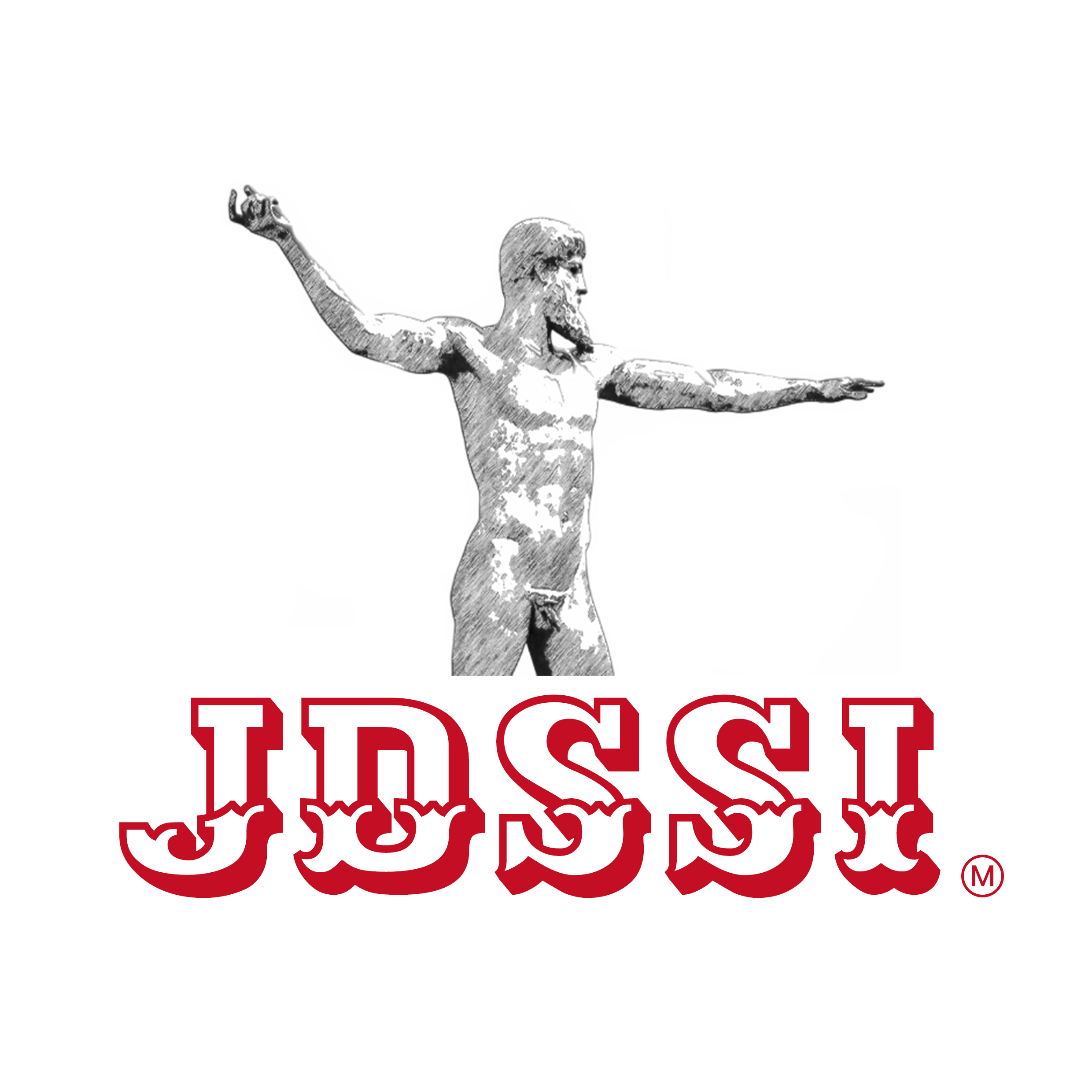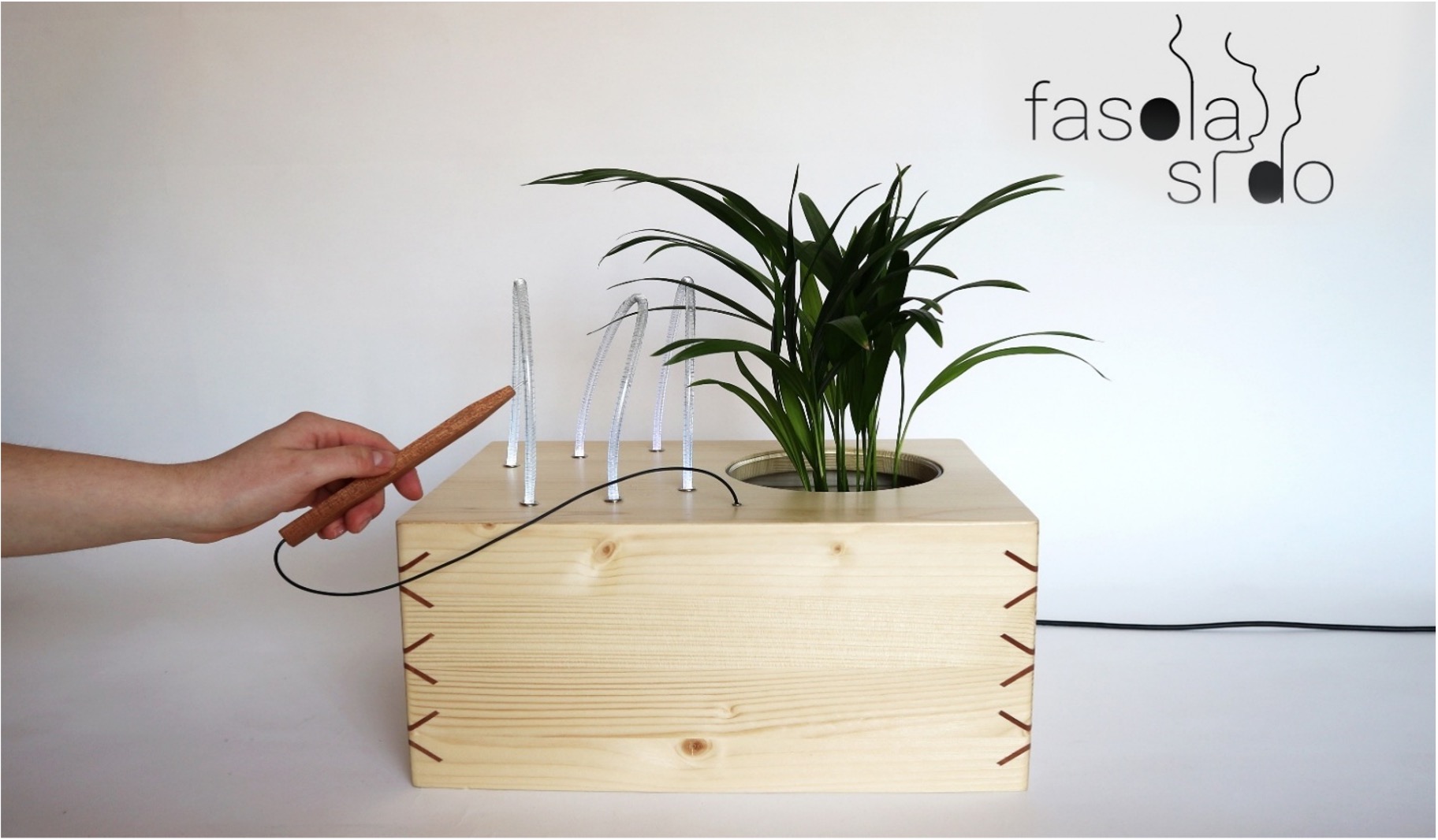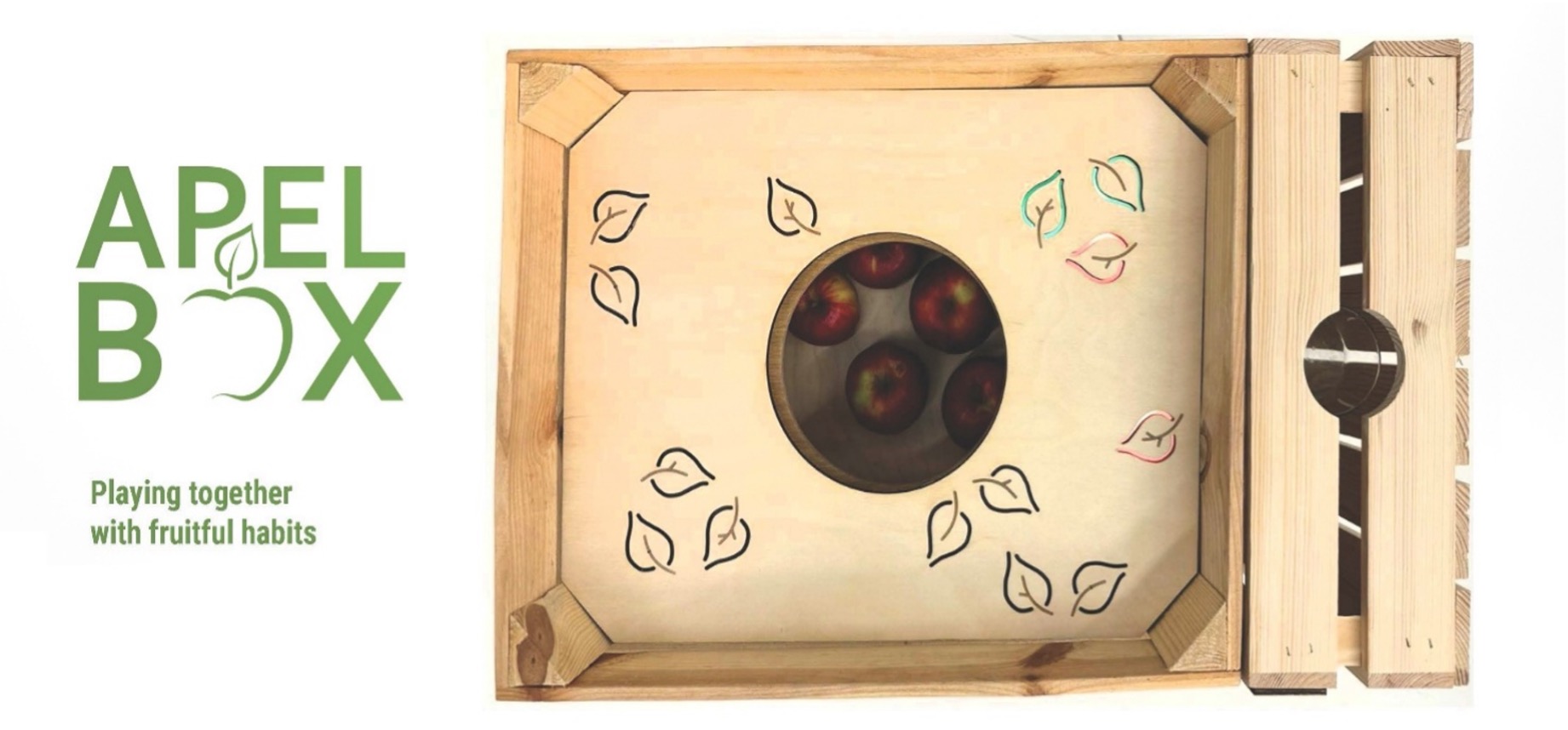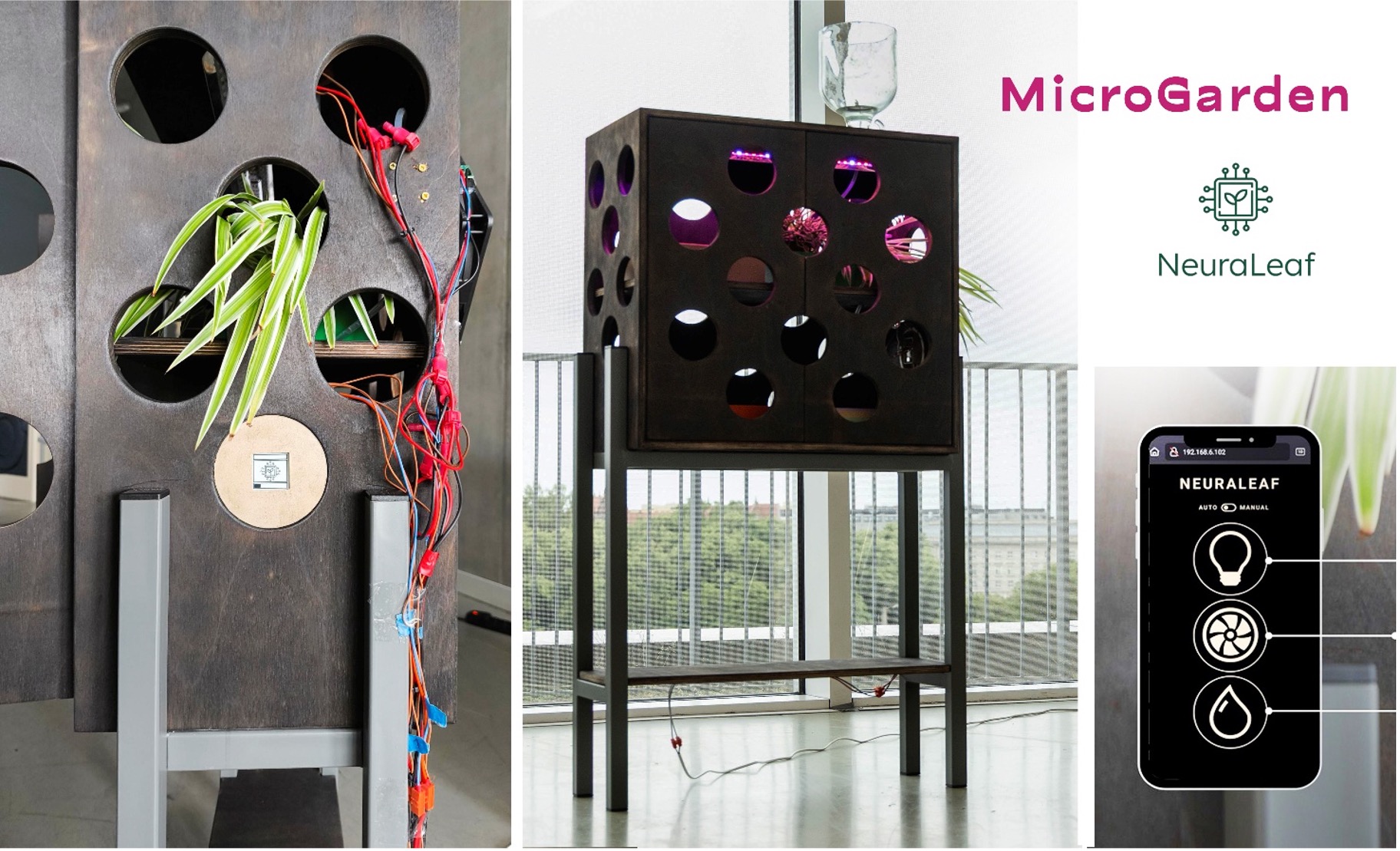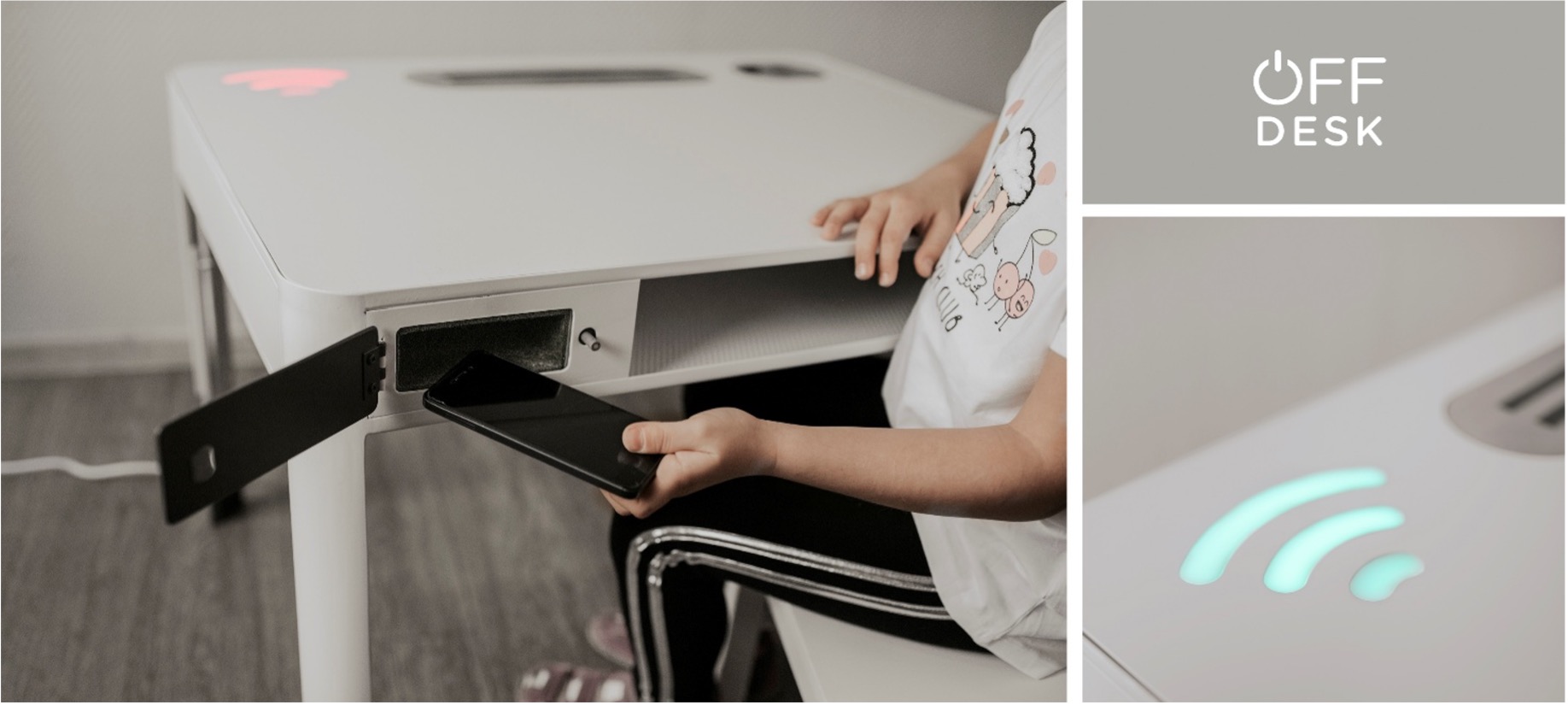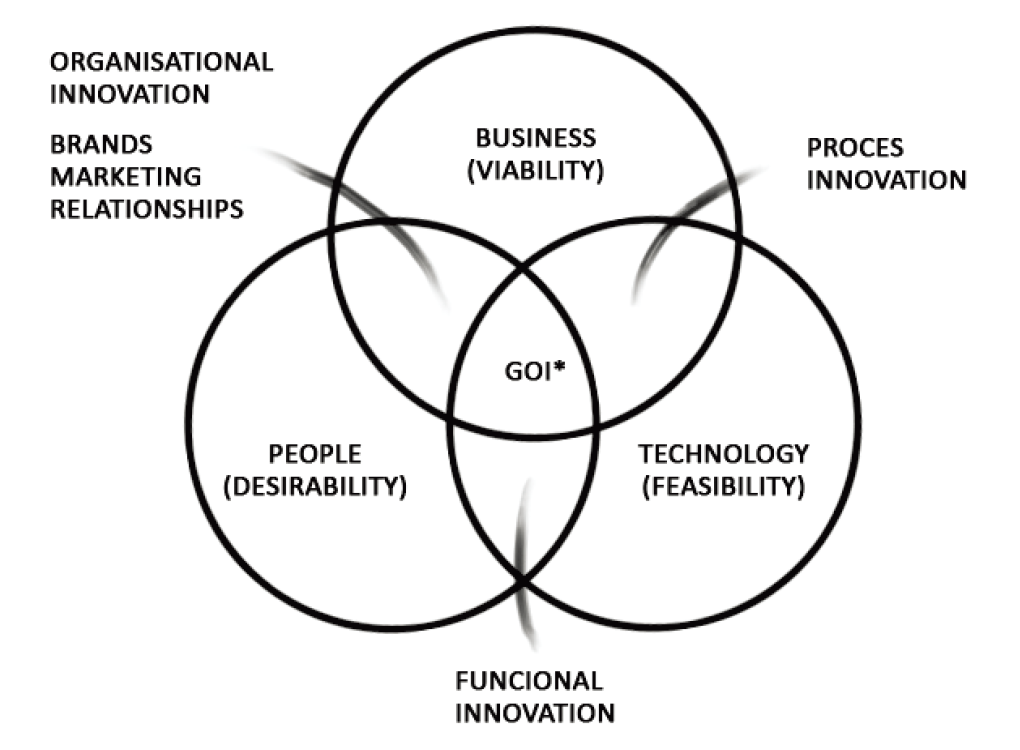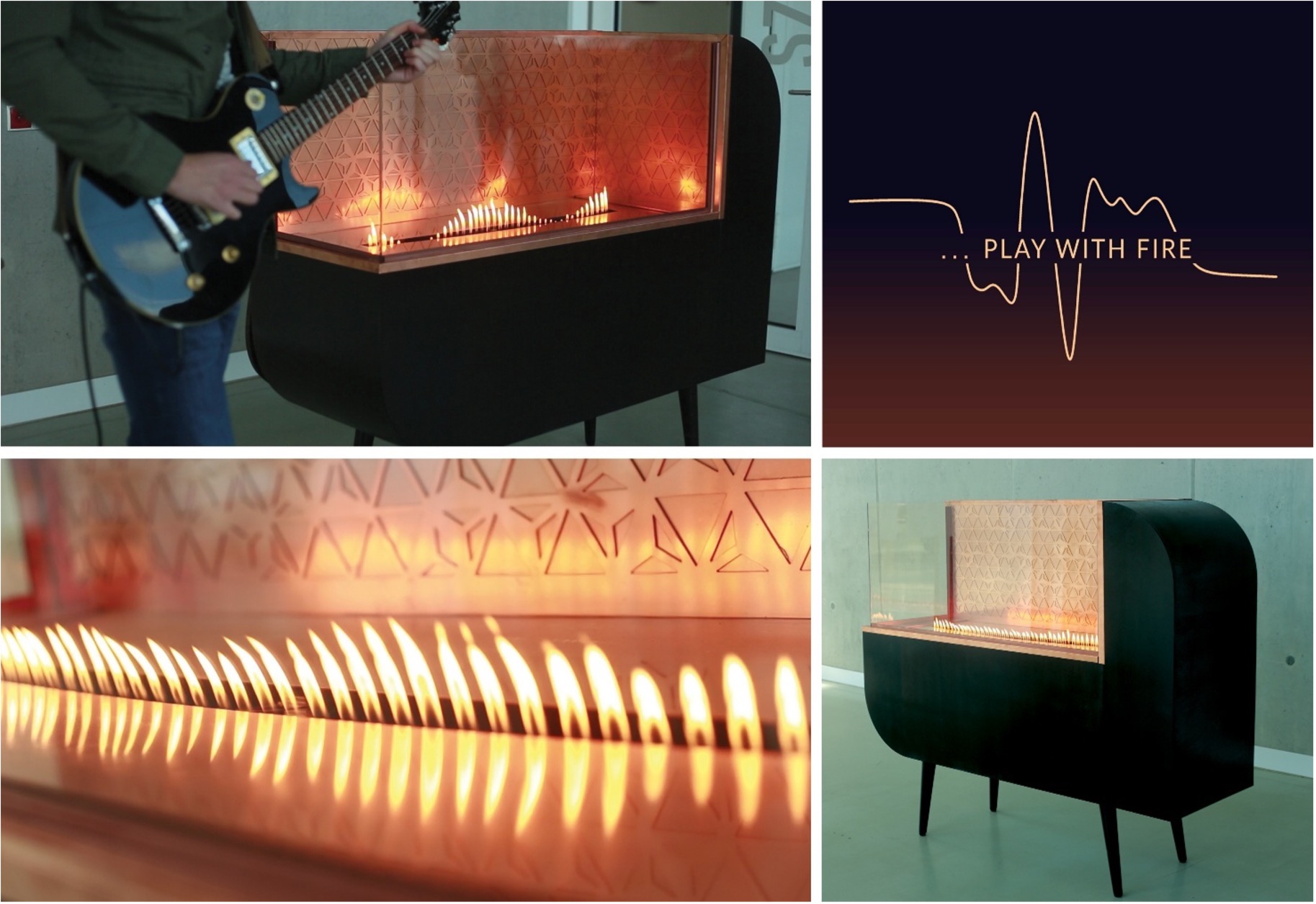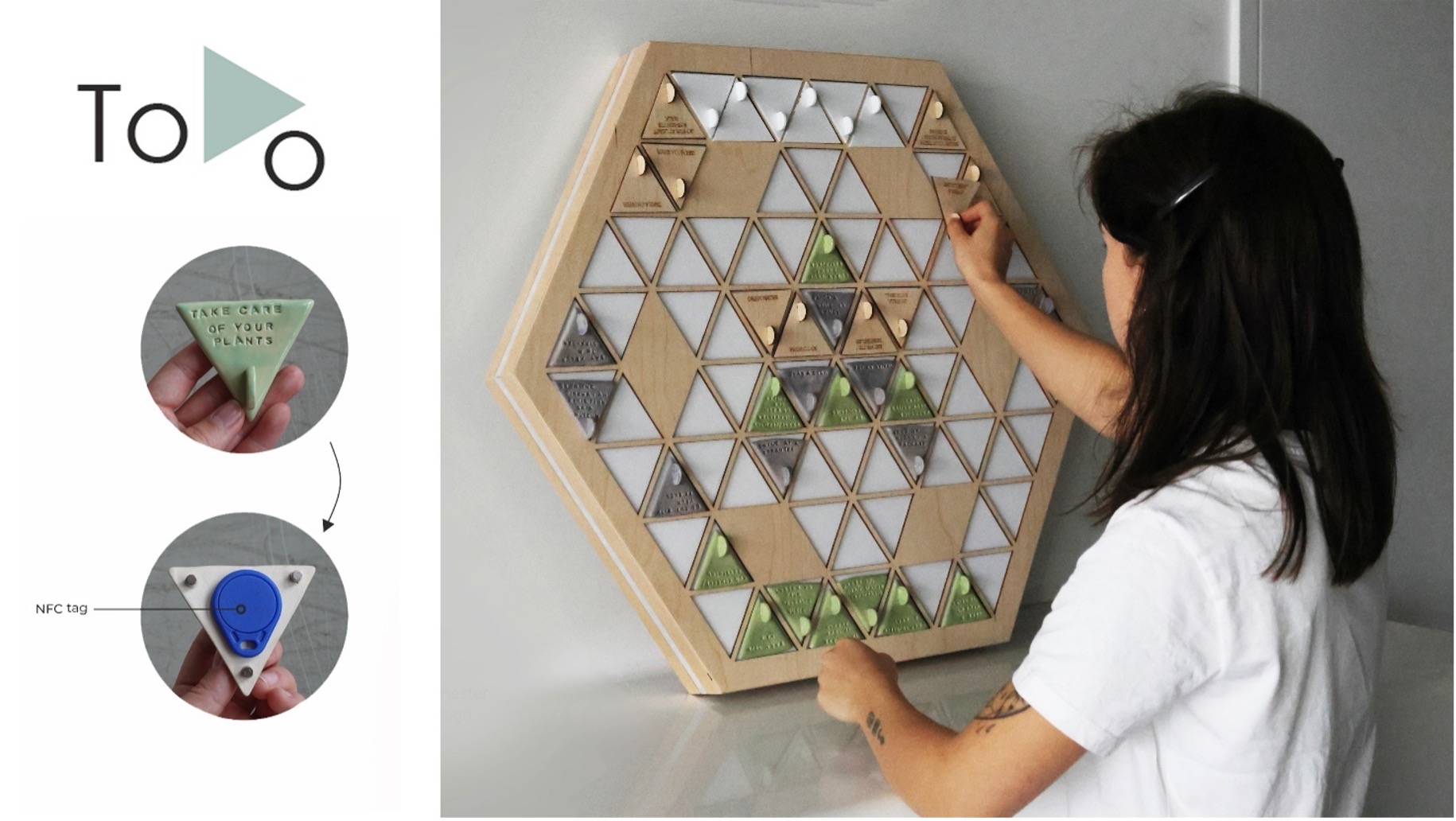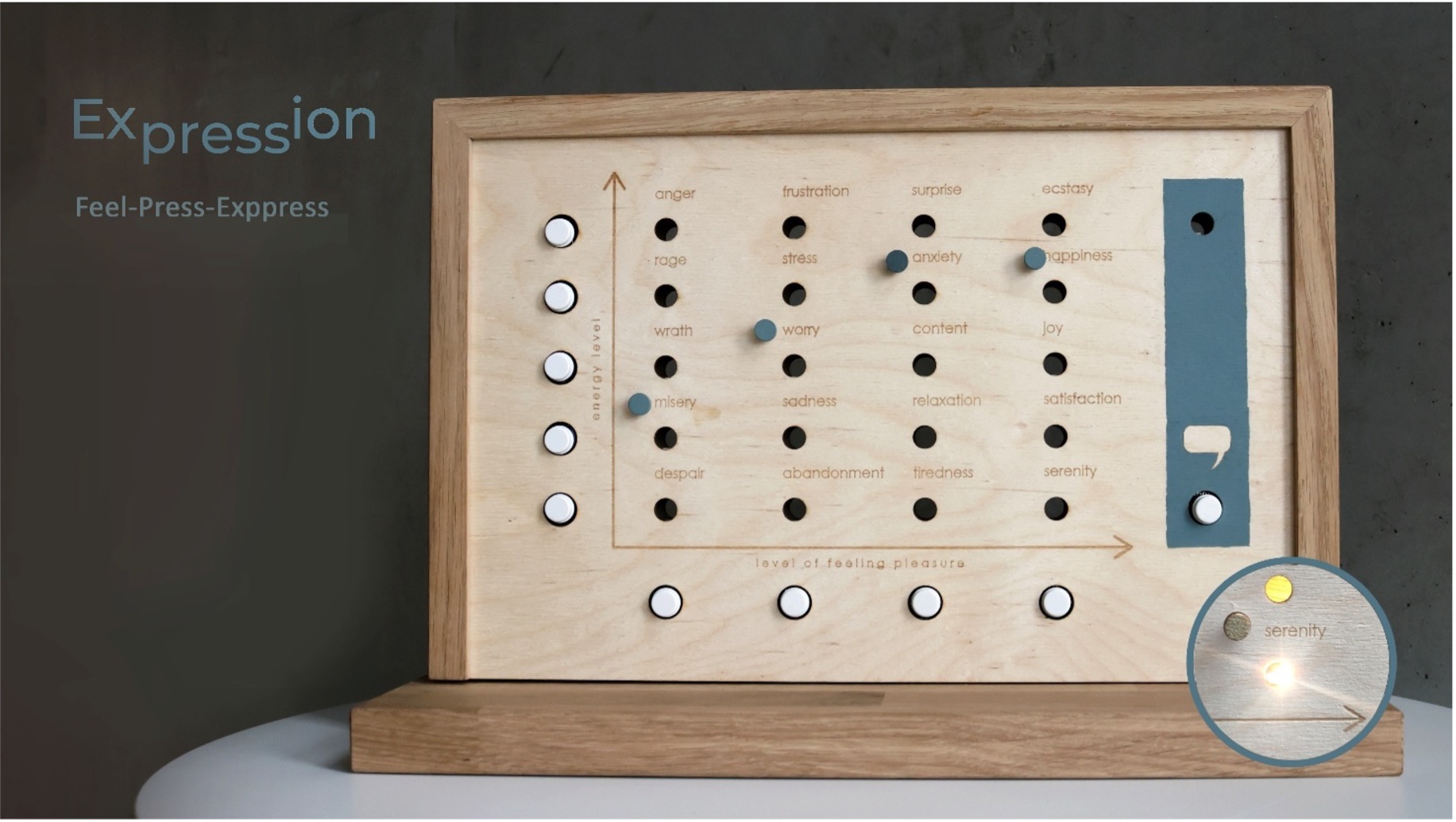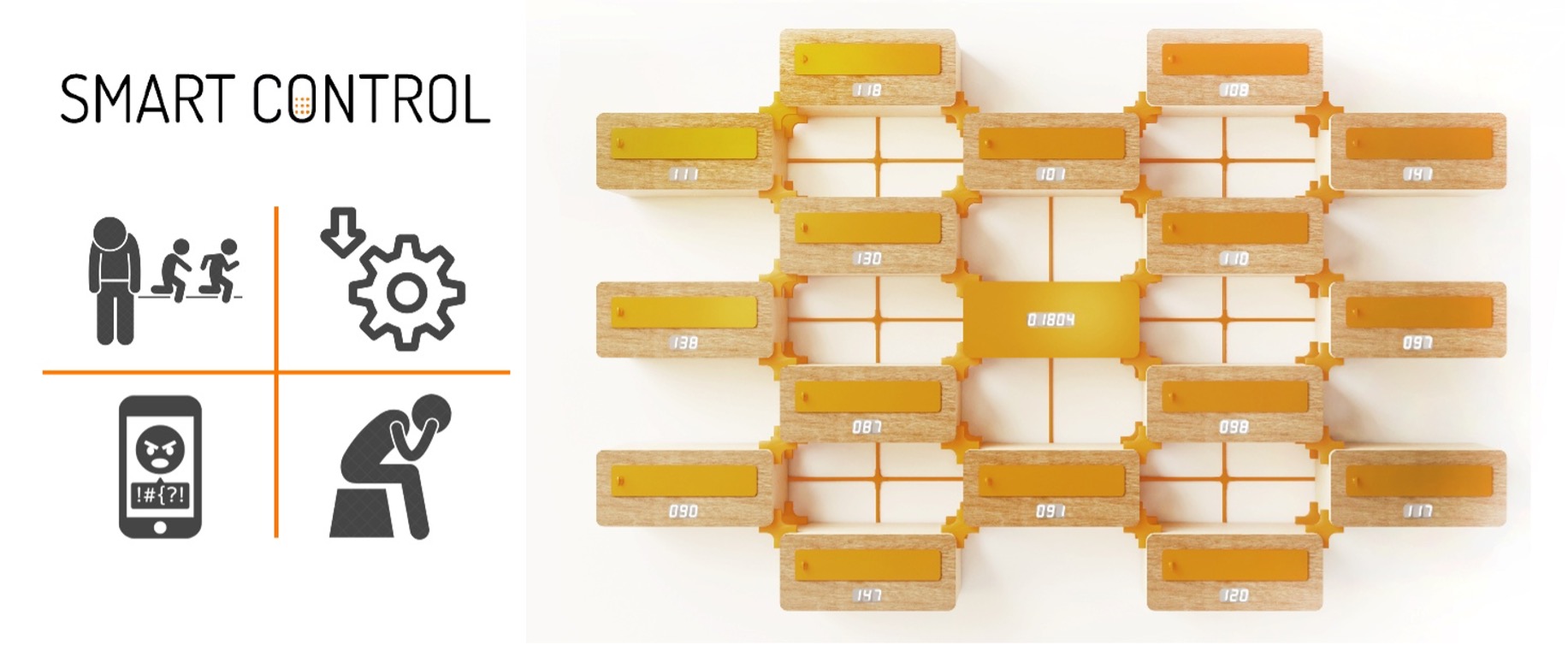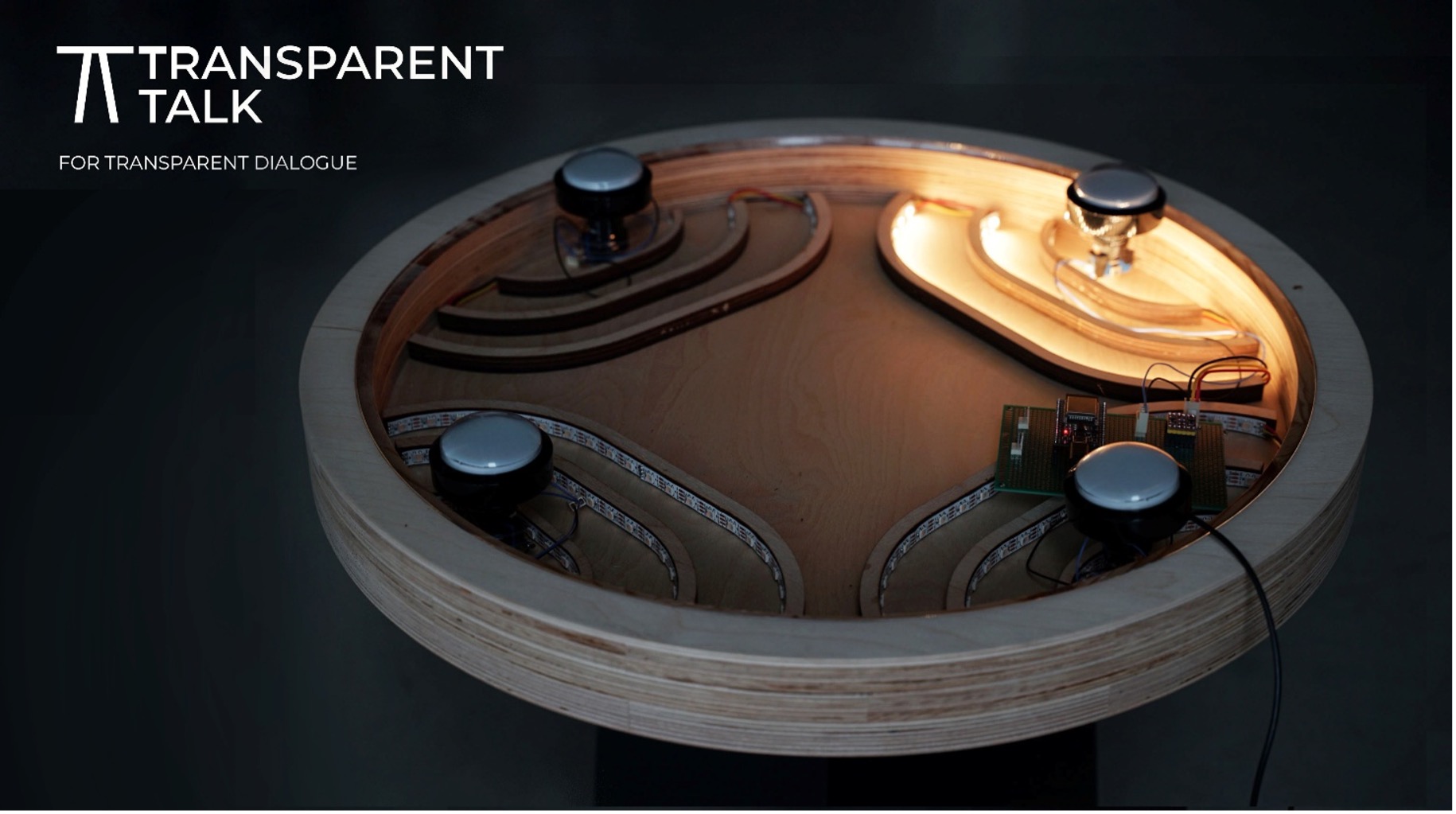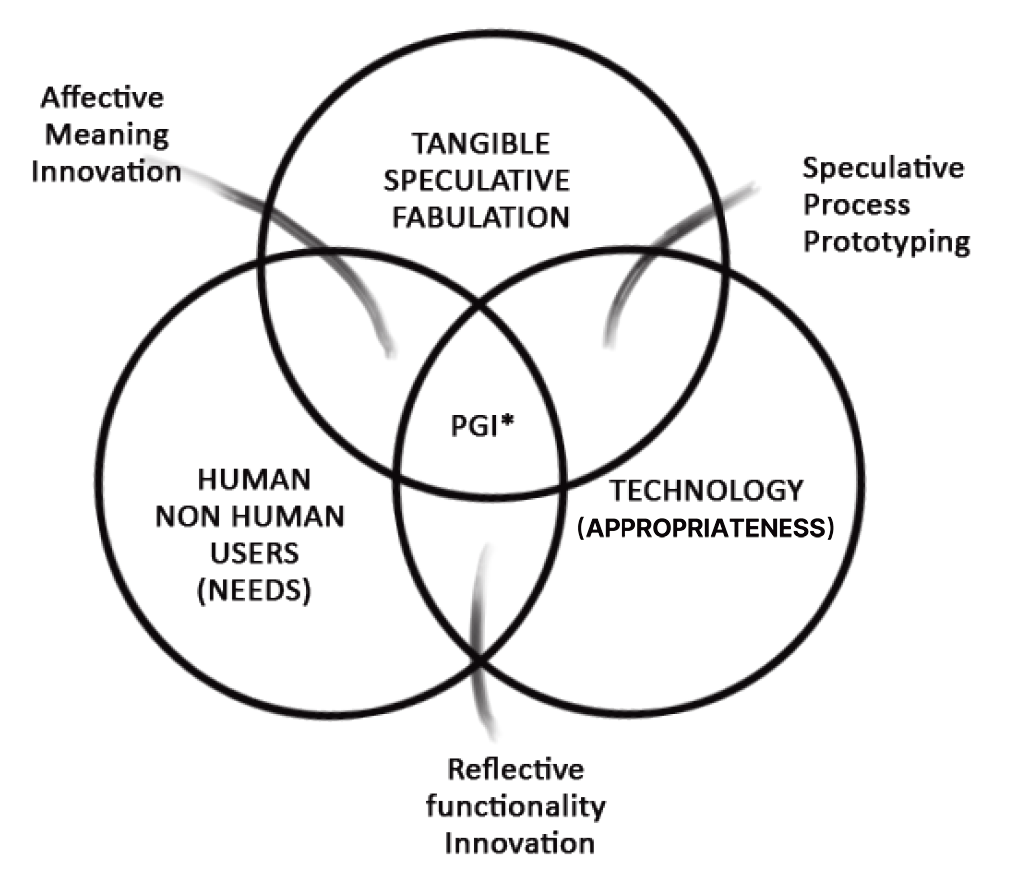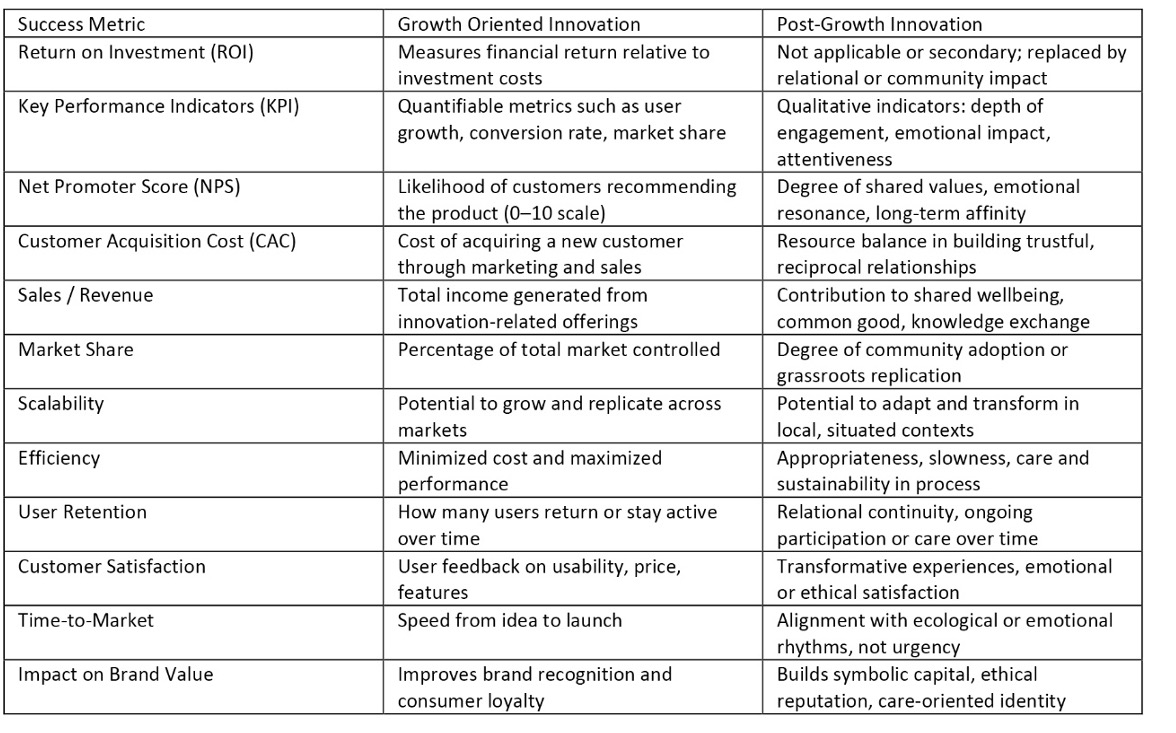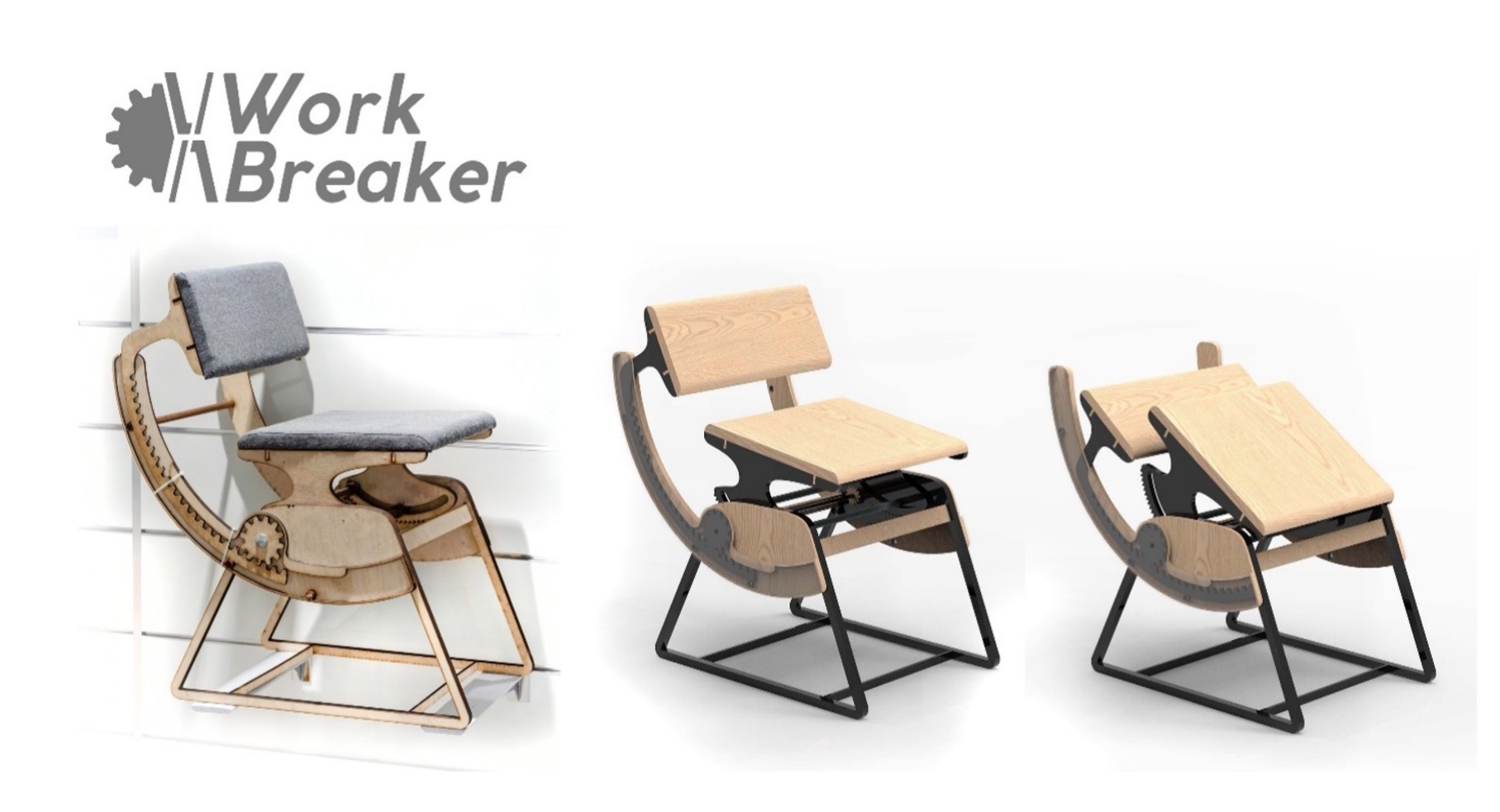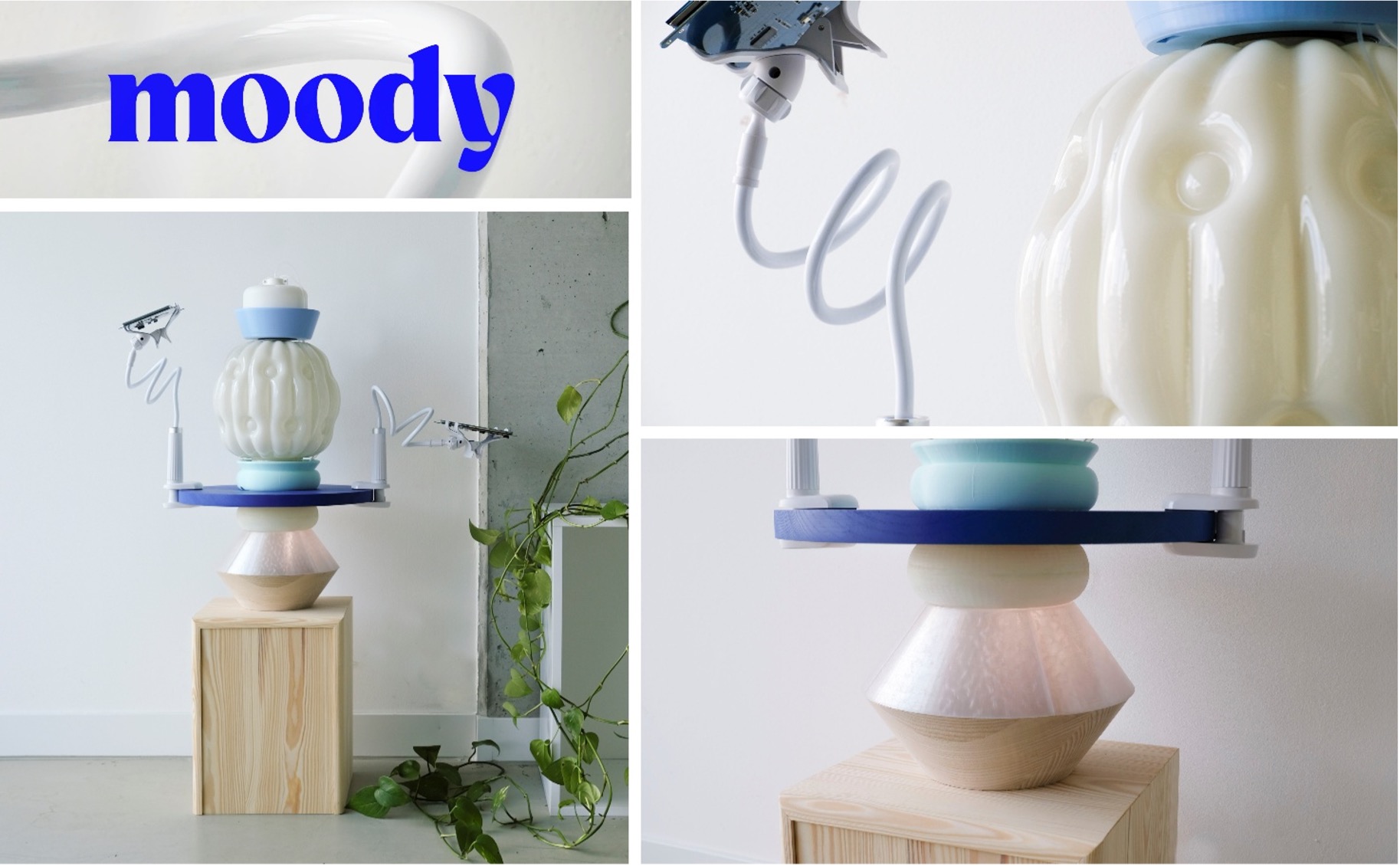Made from woodworking scraps charred using the Japanese shou sugi ban technique, the piece also incorporates a repurposed wine container and 3D-printed bio-wood pots. As a post-growth innovation, Microgarden refers to the idea of plant-centred design, expressing the equal importance of human and plant needs [46]. A key feature of the object is that technology does not dominate humans or nature. Instead, it creates conditions for their mutual well-being.
Another project that develops this assumption is Fasola Si Do by Marta Kluba [47]. It is an interactive plant pot with a function for generating music for plants (Figure 10). The author was inspired by the hypothesis that sound—perceived as a physical phenomenon transmitting various kinds of vibrations—may stimulate plant growth. The music is generated using a wire probe brought close to one of three loops made of resistance wire. This act, interpreted as an expression of tenderness and refined care for non-human beings, deepens the user's sense of interspecies connection and responsibility.
The relationality manifested in MDS projects—understood primarily as an exploration of the bonds between humans and their surroundings—does not limit itself to the natural world. Equally important are inquiries into our relationships with technology. An example of such an approach is Off Desk [48], an interactive school desk with an audio-visual system that encourages students to set aside their mobile phones during class time (Figure 11). The object features a built-in Faraday cage designed to store smartphones during lessons. Since it blocks access to external electromagnetic fields, a phone placed inside becomes practically non-functional. In this case, interactive technologies are used to foster conscious distance from the digital environment. Users’ mindfulness and intrinsic motivation are stimulated through light and sound signals generated by the object. A backlit Wi-Fi symbol on the desk’s surface, glowing in a specific colour, indicates a request to put the phone away. As a reward for completing the task, the desk generates a pleasant sound (e.g., birdsong, applause), which can be personalized. Simultaneously, the Wi-Fi symbol changes to a light blue colour.
Another prototype in which light plays a key role is Apel Box by Wiktoria Białas [44]. Made from a repurposed apple crate, this is a game that promotes students’ health and the ecological reuse of organic waste (Figure 8). Apel box can serve as a tool in broader educational scenarios. The object’s goal is to encourage users to eat as many apples as possible, using game-based motivation. Each time an apple is taken from the crate and the core is returned to the adjacent composter, a point is generated, allowing the number of apples eaten in a classroom over a given period to be counted. The aim is to collect points as a class, while promoting healthy eating habits and environmentally conscious behaviour.
Table of Contents
- Abstract
- 1. Innovation in Urgency Mode or Design at the End of Growth: Rush and Productivity
- 2. Design in the Service of the Market versus the Risk Society
- 3. An Alternative Path to Innovation: MDS Values and Principles
- 4. The MDS Case: Practicing Post-Growth, Misread Institutionally
- 5. Towards a Definition of Post-Growth Innovation
- Funding
- Acknowledgements
- Conflicts of Interest
- Author Biographies
- References
Another interesting object for self-observation is Expression by Aleksandra Czechowska [42]. Inspired by the game Battleship, it supports real-time recognition, observation, and expression of emotions (Figure 6). Designed to encourage attentive dialogue, it promotes honest communication and can be an effective tool for psychotherapists. A portable wooden screen with an imprinted emotion grid, it allows users to indicate the feelings evoked during a conversation by pressing one of several buttons. Each button illuminates the corresponding emotion point, visible to the conversation partner on the other side of the screen. Additional magnetic tokens enable the visual, turn-based recording of emotional states experienced by the interlocutors during the exchange. Expression illustrates the affective landscape of a conversation between close individuals, helping them name affective states and observe their emotional sources.
Innovation in this context does not optimize—it transforms. It does not solve problems, but rather activates alternative ways of experiencing, sharing, and understanding them.
This approach not only critiques conventional, growth-oriented innovations but also—by consciously reinterpreting the meaning of Schumpeter’s words—envisions creative constructions that integrate technology with society prioritizing care, reflection, and sustainability. Creativity becomes the central, dominant element, while destruction is replaced by the practice of ethics and care.
In light of these reflections, a reframing of the mainstream definition of design proposed by Tim Brown is suggested. From a post-growth perspective, the definition of design might read as follows: “A discipline that applies the designer’s sensibility and methods to meet the needs of humans and nonhumans, in ways that are technologically meaningful, accessible, and appropriate—and that collective imagination can transform into new paradigms, practices, and solutions for a sustainable future.”
In opposition to passive consumerism, MDS approaches envision design as a catalyst for participatory, ethical, and context-sensitive transformations. Situated within creative practices at the intersection of design and visual arts, this position uniquely combines aesthetic innovation with critical inquiry, opening new pathways to reimagine the role of technology in society. Technologies featured in MDS projects, although not empathic in themselves, become media for empathy through the way they are contextualized in the design scenario. Interactive objects with relational functionality support user connection, engagement, and awareness.
The authors of these prototypes consciously distance themselves from techno-corporate systems of dominance. Their aim is to transform soulless functionality into a carrier of meaning. They do not pursue technology for its own sake. Instead, they integrate it as a key, complementary layer in the design process—always in service of empathy, critical introspection, and relational experience.
This approach echoes the idea of relationality, highlighted in Illich’s [52] work as one of the so-called convivial tools, later expanded by Pansera and Fressoli (2021) in their article “Innovation without growth: Frameworks for understanding technological change in a postgrowth era.”
Drawing on Illich [53], the Appropriate Technology Movement [54, 55], and Schumpeter’s early work [56], they developed a matrix for assessing the extent to which forms of innovation challenge capitalist logic, and can thus be considered post-growth.
The author of this article sees a strong synergy between their proposed indicators and the design approach adopted in MDS. Accordingly, the project-based examples presented here can be considered post-growth innovations. Among the matrix’s criteria, in addition to relationality, Pansera and Fressoli highlight accessibility, adaptability, bio-interaction, and appropriateness. Projects developed within the Mindful Design Studio align well with many of these indicators—fully in some cases, partially in others—which nonetheless confirms their overall consistency with post-growth innovation principles.
The studio emphasizes democratizing technological experience, giving designers and users the tools to create and adapt their own media. By foregrounding the political and relational dimensions of technological creation, digital making—understood as a form of craft—gains the status of a cultural and epistemological intervention [57]. This craft-based approach fosters deeper material understanding of technological matter, confronting fears associated with techno-dominance.
Abstract: Success in the 20th century was measured through the prism of unceasing progress. Such dynamics shaped a specific type of population: a hyper-society, which is the result of “multiplying innovation by increased activity, speed of communication, and social interpellations.” Unfortunately, innovation, which defines the hyper-human, seen from the perspective of ecological economics, blindly echoes the idea of economic growth, which leads us to so-called creative destruction. It is a negative force that has separated us from nature, making us fatter, sadder, and more tired. Therefore, there is an urgent need to redefine the concept of successful innovation—a need to revise innovation as a paradigm based on the idea of productivity and profit.
The tool to fulfil this mission can be design, which is today considered the most important factor of economic and cultural exchange. Hacking the growth-oriented image of design, the author associates it with post-growth innovation, strongly related to ethics, the environment, and society. She presents the activities of the Mindful Design Studio (MDS) of the Wroclaw Design Academy, an interdisciplinary platform with an experimental approach that combines design, simple interactive technologies, and socio-ecological awareness. The main catalyst here is techno-empathy, as well as design as a kind of speculative fiction, expressing disapproval of consumer reality, referring to mindfulness, critique, fiction, and prototyping of the future.
The studio believes in the potential of unconventional imaginaries for technological innovation. Rather than reinforcing the traditional nodes between progress and economic growth, prototypes from MDS demonstrate how innovation can be oriented toward supporting collective well-being, environmental responsibility, and more inclusive forms of techno-engagement. Such an approach not only critiques conventional growth-oriented innovation but also envisions creative constructions of integrating technology into society that prioritize care, reflection, and sustainability.
Dominika Sobolewska *
by
As one possible option, the author points to the post-growth concept of innovation—rooted in the field of ecological economics—which is strongly tied to ethical, environmental, and social well-being. Highlighting the deformative effects of economic acceleration on quality of life on Earth, the article addresses the notion of global health, placing the Planet and its inhabitants on equal footing. To intervene in the speeding dynamics of the growth era, the imperative “Time is money” [9] is here replaced with the motto: “Time is reflection.” As an antidote, the article presents case studies of good practices—such as the activities of the Mindful Design Studio at the Wrocław Academy of Art & Design (MDS).
This didactic and research-oriented studio bringing together specialists from various fields—designers, makers, artists, and programmers—aims to slow down the pace of contemporary life and promote a slow-down approach. Recent research points to a trend of life acceleration, particularly evident in urban environments. The escalation of the pace of daily activities and individual lifestyles was illustrated, for instance, by an experiment conducted between 1994 and 2006 by Richard Wiseman and the British Council [10]. By measuring pedestrian walking speed in various cities, they found that, on average, pedestrian walking peace had increased by 10% compared to data collected in 1994, with some cities showing even more dramatic changes.
This continuous acceleration—often celebrated as a symptom of progress and efficiency—unfortunately has profound implications for individuals’ mental and physical health. The cult of success and productivity fosters a culture in which care for others (both human and non-human) is marginalized, leading to a decline in the quality of our social bonds and a general sense of disconnection from the ecosystem.
There is also a growing prevalence of civilization-related illnesses such as depression, anxiety disorders, climate anxiety, chronic stress, burnout, ADHD, psychosomatic disorders, and social isolation. Clearly, as a result of our so-called growth-driven pursuits, we have become heavier, sadder, and more exhausted.
Eugeniusz Geppert Academy of Art and Design, Wroclaw, Poland
* Author to whom correspondence should be addressed.
JDSSI. 2025, 3(3), 1-25; https://doi.org/10.59528/ms.jdssi2025.0801a37
Received: May 12, 2025 | Accepted: July 15, 2025 | Published: August 1, 2025
According to the vision of Tim Brown, long-time CEO of IDEO and a prominent advocate of design thinking and growth-oriented innovation, design serves as a “discipline that uses the designer’s sensibility and methods to match people’s needs with what is technologically feasible and what a viable business strategy can convert into customer value and market opportunity [11]. ”
This perspective has shaped a specific type of society that the German sociologist Ulrich Beck [12] calls a risk society (German: Risikogesellschaft). In his view, humanity constitutes a peculiar collective that fervently and continuously strives to produce so-called material goods, which do more harm than good to the living environment of contemporary societies. The production of these supposed goods is, in fact, the source of today’s global risks—such as environmental pollution, technological disasters, climate change, and health threats.
Referring to this state of affairs, Kazimierz Krzysztofek, a Polish sociologist and media expert, emphasizes that it is a “system that totalizes human existence throughout almost the entire life cycle; the most productive system in history, whose guiding principle is the intensive exploitation of all resources: physical, human, cultural, and others [13].” The type of innovation Krzysztofek refers to—characteristic of Western business paradigms—is, from the perspective of contemporary ecological economics [14], blindly aligned with the idea of economic growth. It fuels instability within competitive market economies and reinforces global inequalities and technological determinism.
The economist and 20th-century thinker Joseph Schumpeter defined this phenomenon as creative destruction [15]. He argued that the emergence of new technologies undermines or nullifies the relevance of previous jobs, skills, and business models. Mainstream innovation, in his view, is often the main cause of disruption to traditional ways of doing things [16, 17], particularly in the context of small local enterprises or agribusinesses. This, in the long term, exacerbates market dominance, limitations in access to certain resources and public goods, and marginalization of specific social sectors. In light of this, there appears to be an urgent need to redefine the notions of time, success, and especially the concept of design-driven innovation associated with them.
Referring to the idea of innovation without growth developed in contemporary economic literature [18], and to the growing body of research demonstrating the role of economic development in generating inequality and social problems [19, 20], the author of this paper advocates a critical revision of innovation as a paradigm rooted in productivity, efficiency, and profit. Since, according to contemporary expert reports [21, 22] and European Commission documents [23, 24], the main driver of innovation is design, this paper proposes beginning a recovery plan from that point. Within the framework of this article, the author reflects on what innovation and design could look like if situated outside of the commercial domain. Drawing on her own academic and teaching experience, she attempts to outwit the consumerist model of the design discipline by consciously balancing between mainstream aesthetics or design methodologies and new socio-civilizational priorities.
These reflections underscore the necessity of changing the goals humanity has pursued for most of the past century. The discussion emphasizes the need to counter progress paradigms based on market models oriented toward economic growth. It calls for a reorientation of human aspiration—from one that is escalatory and pyramidal, to one that is contracting and structurally unstacked.
The author sees a need to redefine the role of design, which has until now been viewed as a tool participating in processes of economic acceleration, closely linked with growth-oriented innovation. But what if design could be liberated from the economic market? What if it were used as a slowing mechanism? What if we applied proven, effective industrial design-driving methods to promote values other than growth? What kind of definition would innovation born under such conditions require?
Such a scenario may seem unrealistic but given the potential of speculative design and creative practices to visualize alternatives, it could serve as a starting point—a signpost toward something entirely new. Although halting, permanently eliminating, or reversing civilizational development may seem impossible, consciously intervening in the existing state of affairs and shaping new paths within technological advancement may offer hope for a healthier future.
Funding
Not applicable.
Acknowledgements
Not applicable.
Conflicts of Interest
The author declares that there are no conflicts of interest related to this research.
Author Biographies
▪ Dominika Sobolewska is an interdisciplinary artist, curator, designer. For several years she has been associated with the Academy of Art&Design in Wroclaw, where in the Department of Interior Design she leads the Mindful Design Studio for Interactive Spaces and Objects. In 2013-15, she was a member of the design team of the Department of Thematic Spaces at Expo Milano 2015. Author of spatial installations, artistic interventions and interactive objects. Advocate of new design paradigms oriented towards empathy, critique, speculation and social mission. Participant in numerous exhibitions and art residencies organized both nationally and internationally. Recent interactive works are oriented towards provoking social-environmental empathy. Through the exploration of various types of media, and especially through participatory processes, the author encourages social reflection on the condition of today's reality. She has presented her works at, among others, Bozar in Brussels, at the 13th WRO Media Art Biennale in Wroclaw and at the Zachęta National Gallery of Art.
References
1. Bińczyk, E. Epoka człowieka: Retoryka i marazm antropocenu. Warsaw: Wydawnictwo Naukowe PWN, 2018.
2. Robinson, K. S. The Ministry for the Future. Orbit, 2020.
3. Verganti, R. Design-Driven Innovation: Changing the Rules of Competition by Radically Innovating What Things Mean. Harvard Business Press, 2009.
4. Morris, W. Hopes and Fears for Art. Ellis & White, 1882.
5. Cumming, E., and W. Kaplan, eds. The Arts and Crafts Movement. Thames & Hudson, 1991.
6. Schön, D. A. The Reflective Practitioner: How Professionals Think in Action. Basic Books, 1983.
7. Buchanan, R. "Wicked Problems in Design Thinking." Design Issues 8, no. 2 (1992): 5–21. [CrossRef]
8. Ellul, J. The Technological Society. Vintage, 1964.
9. Franklin, B. "Advice to a Young Tradesman." In The Works of Benjamin Franklin, Vol. 2, 267–269. 1748. https://founders.archives.gov/documents/Franklin/01-03-02-0130.
10. Wiseman, R. "The Pace of Life." 2007. http://www.richardwiseman.com/quirkology/pace_home.htm.
11. Brown, T. Change by Design: How Design Thinking Creates New Alternatives for Business and Society. Harvard Business Press, 2009.
12. Beck, U. Risk Society: Towards a New Modernity. Sage Publications, 1992.
13. Krzysztofek, K. "Zdekodowane kody." In Kody McLuhana: Topografia nowych mediów, edited by A. Maj and M. Dery-Nowakowski, 9–17. Wydawnictwo Naukowe ExMachina, 2009.
14. Pansera, M., and M. Fressoli. "Innovation without Growth: Frameworks for Understanding Technological Change in a Post-Growth Era." Organization 28, no. 3 (2021): 380–404. [CrossRef]
15. Schumpeter, J. A. Capitalism, Socialism and Democracy. New York: Harper & Brothers, 1942.
16. Cozzens, S., and R. Kaplinsky. “Innovation, Poverty and Inequality: Cause, Coincidence, or Co-Evolution?” In Handbook of Innovation System and Developing Countries, edited by B.-A. Lundvall, 57–82. Cheltenham, UK: Edward Elgar, 2009. [CrossRef]
17. Cozzens, S., and D. Thakur. Innovation and Inequality: Emerging Technologies in an Unequal World. Cheltenham, UK: Edward Elgar, 2014. [CrossRef]
18. Pansera, M., and M. Fressoli. "Innovation without Growth: Frameworks for Understanding Technological Change in a Post-Growth Era." Organization 28, no. 3 (2021): 380–404. [CrossRef]
19. Kallis, G. Degrowth. Newcastle upon Tyne: Agenda Publishing, 2018.
20. Jackson, T. Prosperity without Growth: Foundations for the Economy of Tomorrow. 2nd ed. Abingdon: Routledge, 2017.
21. McKinsey & Company. The Business Value of Design. 2018. https://www.mckinsey.com/capabilities/mckinsey-design/our-insights/the-business-value-of-design.
22. Motiv Strategies, and Design Management Institute. Design Value Index: Design-Driven Companies Outperform the S&P 500. 2015. https://www.dmi.org/page/DesignValue.
23. European Commission. Design as a Driver of User-Centred Innovation. Luxembourg: Publications Office of the European Union, 2009.
24. European Commission. Implementing an Action Plan for Design-Driven Innovation. Luxembourg: Publications Office of the European Union, 2013.
25. Ghosh, A. The Great Derangement: Climate Change and the Unthinkable. Chicago: University of Chicago Press, 2016. [CrossRef]
26. Kabat-Zinn, J. Wherever You Go, There You Are: Mindfulness Meditation in Everyday Life. New York: Hyperion, 1994.
27. McHoul, A., and W. Grace. A Foucault Primer: Discourse, Power and the Subject. Melbourne: Melbourne University Press, 1993.
28. Schumpeter, J. A. Capitalism, Socialism and Democracy. New York: Harper & Brothers, 1942.
29. Zahavi, D. "Empathy." In The Stanford Encyclopedia of Philosophy (Fall 2017 Edition), edited by E. N. Zalta. 2017. https://plato.stanford.edu/archives/fall2017/entries/empathy/.
30. Wiseman, R. "The Pace of Life." 2007. http://www.richardwiseman.com/quirkology/pace_home.htm.
31. Decety, J., and C. Lamm. "Human Empathy Through the Lens of Social Neuroscience." The Scientific World Journal 6 (2006): 1146–1163. [CrossRef]
32. Couros, G. Technology Will Not Replace Great Teachers, But Technology In The Hands of Great Teachers Can Be Transformational. 2015. https://georgecouros.ca/blog/archives/5382.
33. Maeda, J. The Laws of Simplicity: Design, Technology, Business, Life. Cambridge, MA: MIT Press, 2006.
34. Niedderer, K. "Designing Mindful Interaction: The Category of the Performative Object." Design Issues 23, no. 1 (2007): 3–17. [CrossRef]
35. Przybysz, S. Work Breaker. Kinetic prototype created during Mindful Design Studio sessions, Wrocław Academy of Art and Design, 2020.
36. Empathic Design. Empathic Design or Technological Concern for a Better Tomorrow [Exhibition website]. n.d. https://empathicdesign.eu/.
37. Oxford English Dictionary Online. "Useful." In Oxford English Dictionary. n.d. https://www.oed.com.
38. Investopedia. "Utility." n.d. https://www.investopedia.com/terms/u/utility.asp.
39. Mikłusiak, W. Moody. Interactive prototype created at Mindful Design Studio, Wrocław Academy of Art and Design, 2024.
40. Łukasik, A. Play with Fire. Interactive prototype. Mindful Design Studio, Wrocław Academy of Art and Design, 2019.
41. Wojciechowska, M. To Do. Interactive prototype. Mindful Design Studio, Wrocław Academy of Art and Design, 2025.
42. Czechowska, A. Expression. Interactive prototype. Mindful Design Studio, Wrocław Academy of Art and Design, 2025.
43. Zawadzka, A. Transparent Talk. Interactive prototype. Mindful Design Studio, Wrocław Academy of Art and Design, 2025.
44. Białas, W. Apel Box. Interactive prototype. Mindful Design Studio, Wrocław Academy of Art and Design, 2024.
45. Wiśniewska, A. Microgarden. Interactive prototype. Mindful Design Studio, Wrocław Academy of Art and Design, 2025.
46. Edwards, A., and I. N. Pettersen. "Designing for Plant–Human Relations." Journal of Sustainable Design 18, no. 1 (2024): 22–35.
47. Kluba, M. Fasola Si Do. Interactive prototype. Mindful Design Studio, Wrocław Academy of Art and Design, 2020.
48. Sitek, A. Off Desk. Interactive prototype. Mindful Design Studio, Wrocław Academy of Art and Design, 2020.
49. Sobolewska, D., and A. Sitek. Smart Control. System of modular school lockers. Mindful Design Studio, Wrocław Academy of Art and Design, 2022.
50. Ryan, R. M., and E. L. Deci. "Self-Determination Theory and the Facilitation of Intrinsic Motivation, Social Development, and Well-Being." American Psychologist 55, no. 1 (2000). [CrossRef]
51. Rozgonjuk, D., K. Saal, and K. Täht. "Problematic Smartphone Use, Deep and Surface Approaches to Learning, and Social Media Use in Lectures." International Journal of Environmental Research and Public Health 15, no. 1 (2018): 92. https://doi.org/10.3390/ijerph15010092. [CrossRef]
52. Illich, I. Tools for Conviviality. New York: Harper & Row, 1973.
53. Illich, I. Tools for Conviviality. New York: Harper & Row, 1973.
54. Willoughby, K. W. Technology Choice: A Critique of the Appropriate Technology Movement. London: Intermediate Technology Publications, 1990.
55. Pansera, M., and M. Fressoli. "Innovation without Growth: Frameworks for Understanding Technological Change in a Post-Growth Era." Organization 28, no. 3 (2021): 380–404. [CrossRef]
56. Schumpeter, J. A. The Theory of Economic Development: An Inquiry into Profits, Capital, Credit, Interest, and the Business Cycle. New Brunswick, NJ: Transaction Publishers, 1934.
57. Rosner, D. K. Critical Fabulations. Cambridge, MA: MIT Press, 2018. [CrossRef]
58. Hertz, G. Critical Making. 2012. http://conceptlab.com/criticalmaking.
59. Honey, M., and D. E. Kanter. Design, Make, Play: Growing the Next Generation of STEM Innovators. New York: Routledge, 2012. https://scispace.com/papers/design-make-play-growing-the-next-generation-of-stem-168pknwhg1.
60. The Economist. “The Third Industrial Revolution.” The Economist, April 21, 2011. https://www.economist.com/node/21553017.
61. Feola, G., and R. Nunes. “Success and Failure of Grassroots Innovations for Addressing Climate Change: The Case of the Transition Movement.” Global Environmental Change 24 (2014): 232–250. [CrossRef]
62. Seyfang, G., and A. Haxeltine. “Growing Grassroots Innovations: Exploring the Role of Community-Based Initiatives in Governing Sustainable Energy Transitions.” Environment and Planning C: Government and Policy 30, no. 3 (2012): 381–400. [CrossRef]
63. Tonkinwise, C. “Just Design.” Medium, July 21, 2015. https://medium.com/@camerontw/just-design-b1f97cb3996f.
64. Streeby, S. Imagining the Future of Climate Change: World-Making Through Science Fiction and Activism. Oakland: University of California Press, 2018. [CrossRef]
65. Whitford, F. Bauhaus. London: Thames & Hudson, 1984.
66. Schumpeter, J. A. The Theory of Economic Development: An Inquiry into Profits, Capital, Credit, Interest, and the Business Cycle. New Brunswick, NJ: Transaction Publishers, 1934.
67. Latour, B. Reassembling the Social: An Introduction to Actor-Network-Theory. Oxford: Oxford University Press, 2005. [CrossRef]
Share and Cite
Chicago/Turabian Style
Sobolewska, Dominika, "Post-Growth Innovation Practice: Techno-empathetic and critical insights from Mindful Design Studio." JDSSI 3, no.3 (2025): 1-25.
AMA Style
Sobolewska D. Post-Growth Innovation Practice: Techno-empathetic and critical insights from Mindful Design Studio. JDSSI. 2025; 3(3): 1-25.
© 2025 by the authors. Published by Michelangelo-scholar Publishing Ltd.
This article is published under the Creative Commons Attribution-NonCommercial-NoDerivs 4.0 International (CC BY-NC-ND, version 4.0) license (https://creativecommons.org/licenses/by-nc-nd/4.0/), which permits non-commercial use, distribution, and reproduction in any medium, provided the original work is properly cited and not modified in any way.
3. An Alternative Path to Innovation: MDS Values and Principles
According to the assertion of the Indian-Bengali writer and essayist Amitav Ghosh [25], the climate crisis is also a crisis of culture, and thus a crisis of the imagination.
Considering this, an extremely important task seems to be the activation of creative channels of human thinking—presenting alternatives to growth-oriented goals or even provoking resistance to a degraded, progress-driven reality. But how can this be achieved? How can we gain or capture people’s attention in the face of the market-driven social order? How can we encourage individuals to choose a contemplative walk across an unexplored flatland rather than an uncritical vertical race?
The key to cultivating social mindfulness may lie in new paradigms of design focused on critical thinking and speculative visions. These can serve as a brake or remedy for the momentum of mainstream development by offering new semantic and emotional values.
Mindfulness is the ability to be present and aware—and to build healthy relationships: with oneself, with others, and with the environment [26]. This competence, promoted by the slow-life philosophy, is today cultivated across a wide range of embodied mental practices such as yoga, meditation, slow food, handicraft, aimless walking, digital detox, and working in tune with the body. It can also manifest in lifestyle choices such as living outside the city, reducing consumption, or pursuing self-sufficiency.
The question that arises in the context of these reflections is the following: can mindfulness, which in many ways stands in opposition to the imperatives of the growth paradigm, serve as an alternative to profit-oriented innovation? How can we make conscious presence itself innovative for a post-growth society?
Post-Growth Innovation Practice: Techno-empathetic and Critical Insights from Mindful Design Studio
1. Innovation in Urgency Mode or Design at the End of Growth: Rush and Productivity
The irresponsible hyperactivity of humankind in the Anthropocene has annihilated the relatively stable equilibrium of the Earth, leaving us in what Binczyk [1] describes as a state of emergency. We are now at a moment when we cannot afford to remain passive. The civilizational revolution of the past century—with its technocratic enthusiasm and unquestioning faith in economic development—has led to a global climate crisis, one that has reverberated significantly not only throughout the health of the planet but also that of humankind. These circumstances, on the one hand, induce paralyzing climate anxiety; on the other, they may serve as a powerful catalyst for constructive change.
Such an optimistic vision was already proposed in 1959 by John F. Kennedy, who, while incorrectly interpreting the Chinese word for crisis, claimed that it consisted of two characters: danger and opportunity. Although this interpretation proved imprecise, the underlying message can still be a source of inspiration and a call to social activism. The disruptions and cultural shifts that arise during crises—when people are more willing, or even forced, to change their habits and expectations, appear to be an appropriate moment for initiating positive transformation.
This article uses such a moment as a starting point to hack today’s reality. Drawing on ideas voiced by Robinson in his book The Ministry for the Future [2], it calls for a critical analysis of the foundations of capitalist economics and its relationship with the design world.
In the 20th century, success was measured through the lens of constant progress and profound transformation. As empirical evidence shows, one of the key pillars of this trajectory is innovation driven by design [3], which has served as a major engine of accelerated economic growth. The culture of innovation, despite its continuous evolution, still relies on principles promoted by an industrial economy focused on market needs and profit.
Design plays a vital role in reinforcing this situation. Its function and values have undergone significant evolution over the past decades, especially due to the industrial revolution in the second half of the 20th century and the rise of consumer capitalism. Initially understood as a system of artisanal production, craftsmanship, and a platform for democratizing the social order [4, 5], design has become a multidirectional, ever-expanding discipline strongly integrated with the market economy. From a field focused on the aesthetic enhancement of objects, it has evolved into a global tool for problem-solving and understanding the world [6, 7]. Its task today is to build a multidimensional language between the economy, technology, and its users.
Design is a term widely used today across various areas of human activity, which on the one hand reflects its potential,but on the other, raises concerns about the inflation of its original identity. Unfortunately, although increasingly associated with socio-environmental contexts, it still cultivates the consumerist model of innovation initiated in the second half of the 20th century—a model whose exploitative logic endorses the necessity and feasibility of infinite growth. The dangerous nature of this kind of innovation was already diagnosed in the 1960s by Ellul [8], who stated that it is driven by an obsession with increasing efficiency and technical solutions, a pursuit that leaves no room for reflection or alternative considerations. Time, in this logic, is treated as a resource to be exploited for generating profit. In such circumstances, it becomes critical to hack the image of contemporary design to visualize sustainable alternatives. It is necessary to shift its servile allegiance to the economic market toward new roles, missions of imagination, and opinion-forming functions.
A compelling role here may be played by the previously mentioned Critical and Speculative Design (CSD), whose influence on shaping social worldviews and lifestyles remains underestimated. Due to the fluidity and partial overlap in the meanings of both terms, the following text will refer to them collectively using the general term CSD. It is a form of design for alternative presents and a harbinger of better futures. It does not solve immediate problems but instead asks: where did these problems come from? and: what if?
In doing so, it engages in a refined social discourse that encourages spontaneous change and the emergence of new innovation paradigms. Discourse, according to Michel Foucault’s perspective [27], is a powerful communication tool, remarkably effective in the field of defining social norms. Discursive design, treated as a catalyst for physically materializing that discourse, therefore possesses significant agency. It is capable not only of slowing down the pace of perceived present time, but also of intervening in its structures—with a mission to critique, educate, and envision alternative futures.
A tangible attempt to prove this thesis is found in the academic and teaching practices carried out at the Mindful Design Studio, seen by its members as a remedy for the crisis of imagination. Here, design is used as a tool to activate users, inspire reflection on personal habits, relationships, and environmental impact—and simultaneously as a speculative medium that opens up space for imagining alternative future scenarios and new meanings.
To strengthen its imaginative impact on audiences, the studio emphasizes combining the design approach with simple interactive technologies. The MDS research team deliberately distances itself from global, large-scale high-tech solutions.
Referring to the ideas of Joseph Schumpeter, a 20th-century economist and thinker, the team sees in them what is known as creative destruction—a force that, in the pursuit of endless economic growth, dismantles traditional systems and structures, leading to disruption and social inequality [28]. In proposing an alternative image of technological innovation, MDS is characterized by a Do-It-Yourself culture, investing time in grassroots, craft-based experiments and low-budget initiatives. They believe that this type of design practice can help shift the paradigm from technological determinism toward constructive, small-scale techno-empathy.
In order to change the harmful profit-oriented model of progress, the MDS team considers it essential to build a new, humanized vision of technology—one that is detached from growth-driven and techno-corporate determinism. Focusing on interactive parameters, they aim to build an emotional bridge between being here and now and the scenario of design discourse. The goal is to strengthen the emotional impact on users and to foster socio-environmental empathy.
Empathy, according to encyclopaedic knowledge, is the ability to feel into the emotional state of other people, beings, and organisms, the ability to adopt their ways of thinking and see reality from their perspective [29]. Unfortunately, this skill—so important for maintaining healthy socio-environmental relationships—seems to be fading into the background due to the progressive acceleration of life [30]. Indeed, the level of empathy is fundamentally influenced by the environment in which we live and the behaviour patterns it promotes. According to current psychological perspectives, empathy is not an innate trait but a result of various factors, among which biological, psychological, and environmental predispositions are key [31]. This supports the view that empathy can, to some extent, be learned. In this context, one may ask: can technology teach empathy?
A possible answer lies in the statement by George Couros, a Canadian educator and promoter of innovative education [32], who claimed: “Technology will not replace great teachers, but technology in the hands of great teachers can be transformational.”
This raises a further question: What is the role of a post-growth designer in teaching techno-empathy? The research and teaching team at Mindful Design Studio seeks to answer this through practice. In line with John Maeda’s vision [33], which places hope in humanizing new technologies as a way to address civilizational threats, they argue that technology should not only fulfil utilitarian functions but also engage users on emotional and artistic levels. A key role of designers is to build new contexts in which technology becomes an authorial tool for stimulating tenderness and mindfulness in users.
This assumption resonates with research by Kristin Niedderer of Manchester Metropolitan University, who explores a new category of artefacts known as performative objects [34]. These are tools that, through the stimulation of user behaviour via their function, encourage reflective thought and intentional interaction. A material embodiment of this approach is the Work Breaker prototype, developed by Szymon Przybysz [35] under the supervision of the MDS research team (Figure 2). It is a kinetic piece of furniture—an antidote for workaholics. Equipped with a gear system driven by motors, it is programmed to interrupt desk work at appropriate intervals.
At a certain moment, its structure folds in a way that forces the user to leave their chair. The furniture piece serves as a humorous commentary on today’s cult of obsessive self-productivity. On the one hand, it is a critique and warning about the current state of affairs; on the other, it envisions a bleak future in which designers may be compelled to intervene in unhealthy behaviour patterns through technological hacking.
Such prototypes are representative artefacts of MDS’s activities. The technologies used in their design disrupt routine actions and provoke emotional reactions. By reimagining the role of objects, the studio promotes a post-growth alternative reality and new future imaginaries. This constitutes a kind of outline—an idea that moves toward an alternative definition of innovation: post-growth, empathetic, and anticipatory, oriented toward the well-being of both people and the planet. A distinctive feature of this innovation is its drive to question the harmful profit-driven system and to provoke grassroots changes in consciousness.
When purposefully applied, technology allied with design not only supports but also protects our social bonds and natural resources, paving the way for transformative consumption patterns and more equitable futures. These issues will be discussed through various design projects and approaches, particularly mindful, critical, and speculative design. Selected examples from Mindful Design Studio show how design, supported by simple technological mechanisms, can intervene in post-growth social inattentiveness. These projects aim to educate, manifest, and challenge the status quo while prototyping futuristic imaginaries. They address not only responsible development but also reflect emotional states, social moods, and our connection with nature. They demonstrate how an empathetic approach to new technologies—techno-empathy—can help promote restorative post-growth goals. Here, design becomes a tool for creating low-tech alternative innovations in response to a damaged reality.
The authors of these projects, responding to contemporary needs and social values, aim to humanize technology by making it more empathetic, accessible, and occasionally even annoying to users. Through the low-budget nature of interactive components and the craft-based, hand-made character of execution, they strive to democratize technology and destigmatize dystopian visions of global techno-control. MDS develops a design approach that transcends aesthetics and functionality, seeking to build perceptual bonds between the present moment and the proposed design narrative. The materialization of the design scenario occurs through peculiar physical prototypes with an interactive, techno-empathetic identity. Importantly, both their realization process and promotional strategy are borrowed from mainstream design practices.
The prototype analyses user-uploaded photographs. In response—and with the help of a custom AI-powered program—it generates scents in real time that correspond to the visual content. Based on qualitative research, the author created a dataset to train the AI algorithm. She identified five different affective states, each associated with a specific scent type: calm (relaxing), energy (stimulating), balance (stabilizing), relief (healing), and delight (sweet, aphrodisiac). The algorithm selects appropriate blends from this list, conveying the atmosphere of the visual materials introduced by the user, which are also displayed on a monitor attached to the object via an articulated arm.
A second monitor illustrates the AI’s data processing in real time—algorithms that analyse the emotional perception of the visual material and initiate the selection of scents that correspond to the recognized affective reactions. Through the narrative of interactive sensory experience, this object generates an immersive space for deep, sentimental retrospection and self-observation.
Another project with a similar affective tone and social mission is Play with Fire (Figure 4). Aleksandra Łukasik [40], drawing on the symbolic and cultural archetype of fire—particularly its role in rituals of passage, purification, or community—designed a singular fireplace for celebrating sensory rest. Combining the aesthetic-functional qualities of refined furniture, a hearth, and a musical instrument, it invites users to mindful contemplation of music accompanied by a fiery spectacle. A characteristic feature of the object is the flame line embedded in a glass chamber along the longer axis of the furniture. This element is part of a built-in gas installation connected to a speaker membrane. Users can activate soundtracks via a music-generating app, or they can create them using an attached musical instrument. The dynamics of the musical piece and instrumental changes influence the shape and intensity of the flames. The fire can change its appearance—from a harmonious line to dramatic leaps reaching several dozen centimetres. The object’s novelty lies in its therapeutic dimension, promoting slow life. Mindful observation of the domesticated element, reinforced by acoustic impulses from musical pieces, fosters an atmosphere of calm and sensory immersion.
This is an intentional act. In doing so, the designer consciously misleads users. Through a commercial form—familiar and accepted by the masses—and accompanying promotional strategies, they aim to smuggle in deeper ideas rooted in activism, speculation, critique, and visionary thinking. Noteworthy is the attention to function and aesthetic value, as well as branding. Yet, brand storytelling here is replaced by ideological communication, consistent with the idea of liberation from the growth imperative. The combination of these traits—traditional implementation processes taken from conventional design, along with mainstream promotional strategies and values detached from the market—serves as a compass for MDS, pointing toward new ways of thinking and toward what is called post-growth innovation.
Mindful Design Studio shares knowledge, encourages experimentation, and disseminates pro-social and pro-ecological approaches through teaching and exhibitions in local and international galleries. This mission is actively promoted through the curatorial exhibition Empathic Design or Technological Concern for a Better Tomorrow, where experimental solutions and prototypes are presented to a wide audience [36]. In this way, the studio creates environments that empower communities through collaborative learning and cooperation.
A defining feature is the accessibility of authorial programming tools, which enable the creation and modification of functions even by individuals without prior coding experience. The aim is to question and challenge the principles of mass production and consumption, as well as to democratize new technologies. This body of work does not follow a clearly defined methodology but rather represents a new approach to the objectives of design.
A different, more complex therapeutic influence is represented by the prototype To Do, created by Maja Wojciechowska [41]. This is a functional object dedicated to people experiencing depressive episodes, for whom completing basic daily activities poses a significant challenge (Figure 5). The object takes the form of an interactive board designed to motivate users by encouraging them to track their progress through a custom interactive system. The prototype consists of a hexagon-shaped panel divided into triangular fields, where users can attach matching ceramic tiles labelled with specific tasks (e.g., eat breakfast, brush teeth, call a friend). The gesture of attaching each tile is recorded via RFID tag technology, accentuated by appropriate field lighting. The daily mosaic of completed tasks is visualized in a custom app, allowing the user to monitor progress and enrich the recorded patterns with new challenges.
4. The MDS Case: Practicing Post-Growth, Misread Institutionally
The prototypes developed at MDS encourage users to reflect on their relationship with consumerism and the planet. These are concepts that are hard to find among market-based solutions. The user narratives embedded in them diverge from the growth paradigm’s canons of profitability, lucrativeness, or financial gain. According to 20th century dictionary terminology, useful meant being helpful, profitable, or advantageous [37].
In a contemporary economic interpretation, based on the belief that consumers will always seek to maximize their utility, the term refers to the total satisfaction or benefit derived from consuming a good or service [38].
However, this definition has evolved significantly over the last century, especially regarding what we consider helpful, profitable, or beneficial—and more importantly: for whom? Should utility serve humans, the economy, health, or perhaps the planet?
Challenging the progressive dynamics of modernity, MDS artefacts provide immaterial value, enriching our well-being. Rooted in design culture and supported by craft-based, appropriate technologies, they respond empathetically to today’s need for moments of reflection and interspecies dialogue.
One example is Moody, created by Weronika Mikłusiak [39] under the academic supervision and with the programming support of the MDS research team (Figure 3). This hybrid furniture-totem is inspired by a simple children’s toy, where various components are stacked onto a centrally mounted axis. The aim is to provoke users to nostalgically explore sensorimotor and memory-based experiences through interactive sensory stimulation.
The theme of environmental relations is a key direction in MDS’s activities. A manifestation of these aspirations is the Microgarden prototype by Aleksandra Wiśniewska [45]. It is a plant-dedicated furniture piece with a built-in intelligent cultivation system (Figure 9). The object combines advanced technology with the principles of sustainable design, offering users the ability to precisely control plant growth conditions via a dedicated online platform. The system allows for the individual adjustment of microclimate parameters to suit a specific plant type. It provides regulation of lighting, irrigation, and ventilation, making it a unique tool for both amateur and advanced plant enthusiasts.
The author of the project, Aleksandra Sitek, recognizing the potential of such narratives for critical media education, further developed the concept in collaboration with Dominika Sobolewska by designing Smart Control [49]. This is a system of modular school lockers for mobile phones, equipped with a deactivation function. It also includes an app or software that logs the time phones are stored in each locker and aggregates the group’s total time spent without mobile devices (Figure 12). The solution was proposed as a starting point—a trigger for an educational scenario prepared with care.
The goal of the interactive furniture-based game is to motivate students and teachers to put away mobile phones during school hours. Participants earn points, which accumulate proportionally to the time their phones remain inactive. Both the point values assigned to various phone-withholding scenarios and the rewards for reaching specific time thresholds can be democratically agreed upon in the early phase of the educational initiative, with the involvement of engaged teachers and, optionally, parents. The reward may be collective—for the entire group—or individual. It may reflect the specific characteristics of the educational institution, encourage students to develop interests outside the digital world, or take the form of fulfilling a collectively agreed-upon charitable goal.
Smart Control, following the theory of self-determination by Richard M. Ryan and Edward L. Deci [50], aims to strengthen self-regulation through intrinsic motivation based on autonomy, competence, and relatedness. The main principles of the project involve giving students control over the decision to set their phones aside during school hours and building intrinsic motivation through gamification strategies and team-based learning [51].
When viewed through the values of the Mindful Design Studio, the project can be considered highly innovative. Its novelty lies not only in the new type of product but also in the new methods of work that result from its application, as well as in the transformative phenomena and added social value it generates. It promotes changes in habits, values, and modes of interpersonal interaction—precisely the kind of systemic change that design should be capable of initiating.
However, this vision of innovation often remains unrecognized or dismissed within institutional frameworks. Evidence for this can be found in the project’s encounter with an innovation incubator in the education sector, which revealed a significant disconnect between the values embodied in the project and the metrics used to validate design as a discipline. Smart Control, as assessed by expert evaluation, received a relatively low score in the category of social innovation. The evaluation was conducted using parameters of linear progress and rapid outcomes—typical of a growth-driven ethos. The project was noted to be incompatible with the logic of economic efficiency as a supreme value. Its potential cultural, transformative, or long-term social impact was largely minimized in favour of quick implementation potential and low production costs. Scalability, economic value, and measurable impact were prioritized.
Unfortunately, many funding bodies, competitions, and innovation programs remain tightly bound to this model of innovation. As shown in the table comparing success indicators of growth-oriented innovation and post-growth innovation, dominant mainstream frameworks tend to favour rapid development, technological novelty, and market readiness—while neglecting slower, more relational design modes that focus on care, situated knowledge, and long-term cultural transformation (Table 1). As a result, alternative forms of innovation—those rooted in pro-social action, critical reflection, or long-term metamorphosis—are often classified as marginal or unproductive.
2. Design in the Service of the Market versus the Risk Society
Today, we design not only architecture, interiors, and accessories, but also systems of thought and the very processes of design. What does this mean in practice? Properly organized designing of design, taking into account the dynamics of civilizational and cultural change, can serve as an effective engine for shaping new lifestyles, behaviours, and social patterns. This fact is skilfully leveraged by the rhetoric of economic growth. Design is treated here as a catalyst for innovation, expansively exploited in the commercial sector. The method of creative problem-solving focuses on three fundamental pillars: people desirability, technology feasibility, and business viability.
As illustrated by the diagram below (Figure 1), in contemporary terms, innovation arises at the intersection of these three spheres, with business viability occupying the privileged, leading position. This is visible not only in the core circles of the diagram but also in the adjacent areas located at their intersections. The main emphasis is placed here on cost reduction, operational efficiency, brand value, and human-centred usability and ergonomics.
Interpersonal dynamics are moderated differently in Transparent Talk by Alicja Zawadzka [43]. Her prototype is a table designed for inclusive conversation, ensuring that each participant has the opportunity to speak (Figure 7). Users interact with the surface via buttons embedded in the tabletop. Each press, signalled by a lit-up area, indicates the intention to speak. Speaking time is measured by the duration of the light signal and is equal for all users. The table records the sequence of button activations, creating a speaking queue and assigning time accordingly. When the moment arrives, the LED strip at the relevant person’s position lights up, symbolically giving them the floor. Light acts here as a moderator—it organizes the rhythm of conversation and highlights the transparency of the process, opening space for every voice. The action scenario can be flexibly adapted depending on the needs of a given discussion and its participants. An important feature of the project that enhances its post-innovation dimension is the ability to visualize the percentage share of each participant’s speaking time. Transparent Talk reveals who dominated the conversation and who had only a minimal presence. This serves as an invitation to self-reflection and conscious inner transformation.
The projects presented in this article are frequently subject to such classifications. The author, motivated by these conflicting experiences, encourages a critical reflection on what innovation truly means in contemporary design discourse. She advocates for expanding the narrative of innovation to include projects that operate through care, slowness, and subtle disruption—rather than through market-driven efficiency.
5. Towards a Definition of Post-Growth Innovation
The prototypes presented in this article can be understood as post-growth innovations. Rather than reinforcing the traditional ties between progress and economic growth, they demonstrate how innovation can be directed toward supporting collective well-being, environmental responsibility, and more inclusive forms of technological engagement. They take the peculiar form of tangible speculative fabulations and serve as catalyst for promoting shifts in worldview and society. The discourse on potential paths of development, agency, and autonomy unfolds here outside the frameworks of global technological systems and market efficiency. In the MDS approach, post-growth innovation is situated at the intersection of the following domains: the desires of humans and non-humans, the capacities of available technologies as affective tools, and speculative material fabulations that give shape to possible alternatives (Figure 13).
MDS activities focus on working with accessible, affordable, and open tools—those that reject corporate rhetoric and remain open to creative reinterpretation. Great emphasis is placed on DIY experimentation and slow, mindful making, aligned with critical making as suggested by Hertz [58], in which physical prototyping becomes a tool for cultural contemplation and a mode of inquiry that challenges dominant narratives around innovation and progress. This approach reflects a culture of bottom-up, alternative creative movements, developed in experimental contexts rather than through industrial-scale production [59, 60]. It is a form of alternative innovation, where small-scale, localized interventions can gradually influence the mainstream, inspiring broader social change.
As noted by scholars such as Feola and Nunes [61] and Seyfang and Haxeltine [62], cultural transformations often stem from such small initiatives that have the power to catalyze sustainable environmental and social development. In the case of MDS, these changes are provoked through the activation of social imagination. Design here is not limited to addressing utilitarian needs—it becomes a field for negotiating new relations between people, objects, and the environment.
As a mechanism of post-growth innovation—not only functional but also social and ecological [63]—it holds potential for influencing daily rituals and shaping collective opinion. As a tool for socio-environmental foresight, it is capable of prototyping solutions for distant futures and proposing narratives that—though seemingly improbable from a growth-centric perspective—push the boundaries of what is possible.
It can thus become a meeting point for interdisciplinary discourses, both scientific and fictional, and a space for generating previously unimaginable patterns. Yet this is not a mutation of science fiction, but rather a critical mechanism that questions the existing order, provokes new modes of thinking, and offers visions of social change through storytelling. This mode of narration is akin to speculative fabulation—a concept derived from the humanities and critical technology studies [64]—which challenges dominant paradigms and proposes posthuman and post-growth alternative narratives.
While speculative fabulation operates primarily within the realm of conceptual inquiry—using storytelling to visualize alternative futures—speculative design (SD) materializes these ideas into concrete artifacts, prototypes, and meanings. As a result, through design, optional visions of the future and alternative presents become more tangible and engaging, making it a platform for the humanization of social life. The design directions manifested through MDS’s practice aspire to be recognized as examples of post-growth innovation.
Not without a touch of irony, one could observe that the kind of innovation illustrated by the post-growth innovation framework (Figure 13) essentially consists in reviving the original, foundational values of design. It is worth noting that in its earliest assumptions, design was neither a market metric nor an instrument of economic growth.
On the contrary, it served as a platform for democratizing social order, restoring the meaning of craft-based work, and building relationships with materiality. This vision became particularly holistic, social, and educational during the Bauhaus era, which often adopted a critical stance toward market imperatives [65]. Originally, then, the discipline emerged as an idea of the common good, an aestheticization and promotion of good craftsmanship. It was only through industrialization and the logic of capitalism that design became an apparatus of optimization, marketing, and image-building.
The post-innovative solutions presented in this article are, in a sense, an attempt to recover the foundational values of design. The strategies of mindful design, discursive provocation, and techno-empathy proposed by MDS can be seen as an embodiment of the process of creative construction, in opposition to the radical disruption of established systems described by Schumpeter [66]. Following the ideas of Bruno Latour [67], one of the most influential thinkers in contemporary social sciences and the author of actor-network theory, these approaches can be seen as integral components of reassembling the social: new ways of experiencing reality—ways that account for discontinuities, co-presence, and the non-human point of view.
